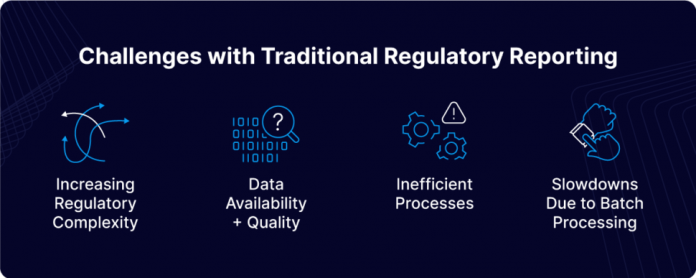In today’s fast-paced regulatory landscape, financial institutions face unprecedented pressure to comply with evolving standards. Traditional reporting methods, burdened by data silos and manual processes, are proving inadequate. Real-time regulatory reporting, powered by stream processing, offers a solution by providing timely and accurate data for compliance.
We’ll explore this transformative approach, starting with an overview of the regulatory landscape. Then, we’ll highlight the shortcomings of traditional reporting methods before diving into the efficiency enhancements of real-time reporting.
A Peek into the Regulatory Landscape for Financial Institutions
The world of regulatory compliance in the financial sector is multifaceted and demanding. Financial institutions handle a tremendous quantity of sensitive data and are subject to regulations including the Dodd-Frank Act, Basel III, the European Market Infrastructure Regulation, and the Markets in Financial Instruments Directive (MiFID).
These regulations share common goals: stringent reporting standards designed to increase transparency, market integrity, and risk management. To comply, institutions must complete tasks such as transaction reporting and anti-money laundering checks.
Non-compliance carries hefty fines and risks significant reputational damage. Consequently, financial institutions must prioritize compliance by reducing data silos, streamlining reporting, and leveraging real-time solutions for effective management of complex financial data. The end goal is to guarantee timely compliance and mitigate risks.
By leveraging real-time data, financial institutions can navigate the regulatory landscape with greater confidence and efficiency.
Challenges with Traditional Regulatory Reporting
Here are some challenges that traditional regulatory reporting is unprepared to address:
Increasing Regulatory Complexity: Regulatory requirements are getting stricter. Consequently, institutions must double-down on compliance efforts.
Data Availability and Quality: Many financial institutions have data silos. These silos result in disjointed, cumbersome processes that are inefficient at best and erroneous at worst.
Inefficient Processes: Manually handling data exacerbates an already tedious process, resulting in reporting delays, which can have an impact on compliance timeliness.
Slowdowns Due to Batch Processing: Traditionally, financial institutions have leaned on batch processing for data reporting. This method involves handling data in large, pre-scheduled batches. As a result, data becomes obsolete rapidly. It’s also time-consuming.
Real-Time Regulatory Reporting: Increasing Efficiency
Real-time regulatory reporting offers a solution to these challenges by enabling continuous monitoring and immediate submission of financial data to regulatory bodies. This approach reduces the time between data generation and regulatory oversight, promising instantaneous updates with sub-second latency. By leveraging stream processing, real-time regulatory reporting ensures that regulatory data is current and reflects the most recent market conditions and transactions.
Real-Time Anomaly Detection and Machine Learning (ML)
Additionally, real-time anomaly detection and machine learning (ML) play pivotal roles in modernizing regulatory reporting for financial institutions.
Integrating these technologies into real-time regulatory frameworks enables institutions to enhance their ability to detect and respond to anomalies swiftly and accurately. Anomaly detection algorithms, powered by ML models such as neural networks, constantly analyze streaming financial data to identify deviations from typical patterns. This proactive approach improves fraud detection and risk management while ensuring compliance by promptly flagging suspicious activities.
Furthermore, ML algorithms can improve over time, learning from new data to refine anomaly detection capabilities further. By leveraging these advanced analytical tools, financial institutions can maintain regulatory compliance with enhanced precision and agility in an increasingly complex regulatory landscape.
Technologies Facilitating Real-Time Regulatory Reporting
The key difference between real-time and traditional regulatory reporting lies in data processing methods. Historically, financial institutions have relied on batch processing, which collects, stores, and processes data in batches at scheduled intervals. However, batch processing is now considered obsolete due to the widespread adoption of stream processing.
Stream processing allows financial institutions to process and transmit data as it occurs, providing a more efficient and streamlined method. This approach guarantees timely compliance with regulatory requirements, minimizes latency, reduces manual processes, and eliminates data silos. It offers regulators a comprehensive, up-to-date view of a company’s financial activities in real-time.
Striim Facilitates Real-Time Regulatory Reporting to Ensure Compliance
Striim excels in facilitating real-time regulatory reporting, ensuring that financial institutions provide regulators with the timely, accurate information they require. By leveraging Striim, organizations can overcome the frustration of navigating data silos.
A defining feature of Striim is its use of Change Data Capture (CDC), which records only new events, resulting in more rapid data uploads. Striim also offers real-time analytics and continuous monitoring, enabling organizations to diagnose and respond to potential challenges as they arise, ensuring ongoing compliance.
Leverage Stream Processing to Supercharge Compliance Efforts
Real-time regulatory reporting represents a significant advancement in the financial industry’s ability to meet regulatory demands. By adopting stream processing technologies like Striim, financial institutions can enhance their compliance efforts, reduce risks, and operate with greater efficiency and confidence in a complex regulatory environment.
Book a demo with us when you’re ready to learn more about how real-time regulatory reporting can help ensure compliance.
The post Real-Time Regulatory Reporting: Streamlining Compliance in Financial Institutions appeared first on Striim.
Read MoreStriim


